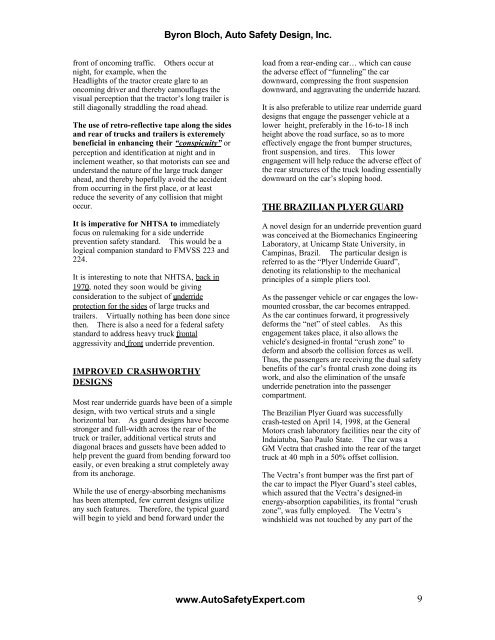Underride Protection
Formula 1 UNDERUN SAFETY A MUST
Formula 1 UNDERUN SAFETY A MUST
You also want an ePaper? Increase the reach of your titles
YUMPU automatically turns print PDFs into web optimized ePapers that Google loves.
Byron Bloch, Auto Safety Design, Inc.<br />
front of oncoming traffic. Others occur at<br />
night, for example, when the<br />
Headlights of the tractor create glare to an<br />
oncoming driver and thereby camouflages the<br />
visual perception that the tractor’s long trailer is<br />
still diagonally straddling the road ahead.<br />
The use of retro-reflective tape along the sides<br />
and rear of trucks and trailers is exteremely<br />
beneficial in enhancing their “conspicuity” or<br />
perception and identification at night and in<br />
inclement weather, so that motorists can see and<br />
understand the nature of the large truck danger<br />
ahead, and thereby hopefully avoid the accident<br />
from occurring in the first place, or at least<br />
reduce the severity of any collision that might<br />
occur.<br />
It is imperative for NHTSA to immediately<br />
focus on rulemaking for a side underride<br />
prevention safety standard. This would be a<br />
logical companion standard to FMVSS 223 and<br />
224.<br />
It is interesting to note that NHTSA, back in<br />
1970 , noted they soon would be giving<br />
consideration to the subject of underride<br />
protection for the sides of large trucks and<br />
trailers. Virtually nothing has been done since<br />
then. There is also a need for a federal safety<br />
standard to address heavy truck frontal<br />
aggressivity and front underride prevention.<br />
IMPROVED CRASHWORTHY<br />
DESIGNS<br />
Most rear underride guards have been of a simple<br />
design, with two vertical struts and a single<br />
horizontal bar. As guard designs have become<br />
stronger and full-width across the rear of the<br />
truck or trailer, additional vertical struts and<br />
diagonal braces and gussets have been added to<br />
help prevent the guard from bending forward too<br />
easily, or even breaking a strut completely away<br />
from its anchorage.<br />
While the use of energy-absorbing mechanisms<br />
has been attempted, few current designs utilize<br />
any such features. Therefore, the typical guard<br />
will begin to yield and bend forward under the<br />
load from a rear-ending car… which can cause<br />
the adverse effect of “funneling” the car<br />
downward, compressing the front suspension<br />
downward, and aggravating the underride hazard.<br />
It is also preferable to utilize rear underride guard<br />
designs that engage the passenger vehicle at a<br />
lower height, preferably in the 16-to-18 inch<br />
height above the road surface, so as to more<br />
effectively engage the front bumper structures,<br />
front suspension, and tires. This lower<br />
engagement will help reduce the adverse effect of<br />
the rear structures of the truck loading essentially<br />
downward on the car’s sloping hood.<br />
THE BRAZILIAN PLYER GUARD<br />
A novel design for an underride prevention guard<br />
was conceived at the Biomechanics Engineering<br />
Laboratory, at Unicamp State University, in<br />
Campinas, Brazil. The particular design is<br />
referred to as the “Plyer <strong>Underride</strong> Guard”,<br />
denoting its relationship to the mechanical<br />
principles of a simple pliers tool.<br />
As the passenger vehicle or car engages the lowmounted<br />
crossbar, the car becomes entrapped.<br />
As the car continues forward, it progressively<br />
deforms the “net” of steel cables. As this<br />
engagement takes place, it also allows the<br />
vehicle's designed-in frontal “crush zone” to<br />
deform and absorb the collision forces as well.<br />
Thus, the passengers are receiving the dual safety<br />
benefits of the car’s frontal crush zone doing its<br />
work, and also the elimination of the unsafe<br />
underride penetration into the passenger<br />
compartment.<br />
The Brazilian Plyer Guard was successfully<br />
crash-tested on April 14, 1998, at the General<br />
Motors crash laboratory facilities near the city of<br />
Indaiatuba, Sao Paulo State. The car was a<br />
GM Vectra that crashed into the rear of the target<br />
truck at 40 mph in a 50% offset collision.<br />
The Vectra’s front bumper was the first part of<br />
the car to impact the Plyer Guard’s steel cables,<br />
which assured that the Vectra’s designed-in<br />
energy-absorption capabilities, its frontal “crush<br />
zone”, was fully employed. The Vectra’s<br />
windshield was not touched by any part of the<br />
www.AutoSafetyExpert.com 9


